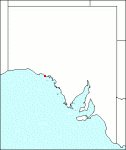Family: Asteraceae
Ixiolaena pluriseta
Citation:
Haegi, sp. nov.
Synonymy: I. tomentosa sensu J. Black, Fl. S. Aust. 907 (1957), partly, non Sonder & F. Muell. ex Sonder.
Common name: None
Description:
Erect shrubby perennial herb 30-80 cm tall with woody lower branches; branches woolly-cobwebby, at length becoming glabrous; leaves oblanceolate, usually narrowly so, acuminate with a soft mucro and margins narrowly recurved, 1-2.5 cm long, 1.5-3 mm wide (rarely to 6 mm), with a dense vestiture of woolly-cobwebby hairs on the underside, moderately to sparsely hairy on the upper side.
Peduncles c. 1 cm long, terminating leafy unbranched branches up to 15 cm long; capitula broadly campanulate to hemispherical (involucre with oblique to almost patent sides), 18-25 mm diam.; involucral bracts broadly linear, the outer ones shorter then the inner, densely woolly-cobwebby, with pale- to dark-brown entire subulate scarious tips; florets evidently pale-yellow.
Seeding heads soft, soon disintegrating; achenes wholly glabrous; pappus bristles 40-70, about as long as the corolla, c. 0.1 mm broad at the base and united for c. 0.2 mm from it.
|
|
Distribution:
|
Apparently uncommon; principally found on calcareous sands of low coastal cliffs and adjacent dunes.
|
Conservation status:
native
Flowering time: Sept. — Oct.
|

SA Distribution Map based
on current data relating to
specimens held in the
State Herbarium of South Australia
|
Biology:
No text
Taxonomic notes:
Holotype: Hj. Eichler 21363, S. Aust., Eyre Peninsula, in sand dunes between the lakes north of Point Sinclair, 32º04'S, 132º59'E, 16.ix.1971 (AD). Isotypes (n.v.): B, CANB, CBG. Haec species ab Ixiolaeniis allis foliis margine anguste recurvis, foliis indumento infra (non supra) densiore, capitulis fiosculisque majoribus, sed praesertim numero majore setarum pappi (40-70, confete usque ad 27) differt. The epithet (Latin plurus many, seta bristle) refers to the large number of pappus bristles, characterising this species.
Author:
Not yet available
|

